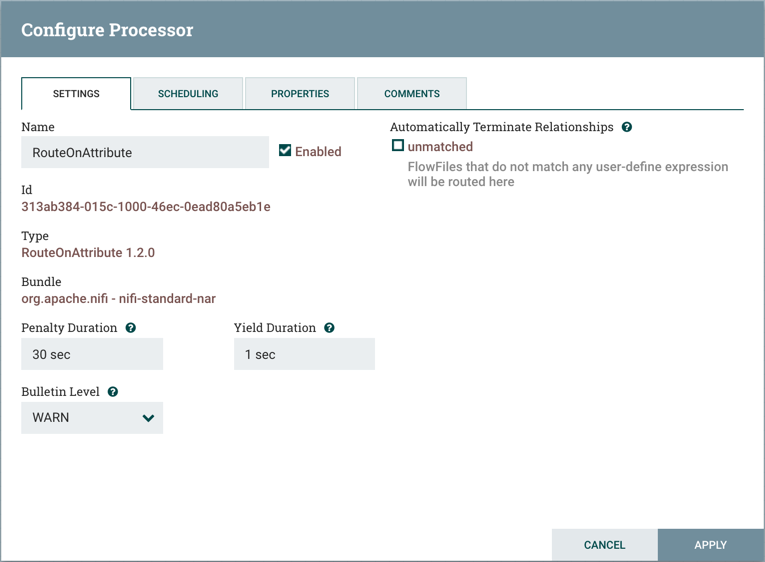Settings Tab
The first tab in the Processor Configuration dialog is the Settings tab:

This tab contains several different configuration items. First, it allows the DFM to change the name of the Processor. The name of a Processor by default is the same as the Processor type. Next to the Processor Name is a checkbox, indicating whether the Processor is Enabled. When a Processor is added to the canvas, it is enabled. If the Processor is disabled, it cannot be started. The disabled state is used to indicate that when a group of Processors is started, such as when a DFM starts an entire Process Group, this (disabled) Processor should be excluded.
Below the Name configuration, the Processor's unique identifier is displayed along with the Processor's type and NAR bundle. These values cannot be modified.
Next are two dialogues for configuring 'Penalty Duration' and 'Yield Duration'. During the normal course of processing a piece of data (a FlowFile), an event may occur that indicates that the data cannot be processed at this time but the data may be processable at a later time. When this occurs, the Processor may choose to Penalize the FlowFile. This will prevent the FlowFile from being Processed for some period of time. For example, if the Processor is to push the data to a remote service, but the remote service already has a file with the same name as the filename that the Processor is specifying, the Processor may penalize the FlowFile. The 'Penalty Duration' allows the DFM to specify how long the FlowFile should be penalized. The default value is 30 seconds.
Similarly, the Processor may determine that some situation exists such that the Processor can no longer make any progress, regardless of the data that it is processing. For example, if a Processor is to push data to a remote service and that service is not responding, the Processor cannot make any progress. As a result, the Processor should 'yield', which will prevent the Processor from being scheduled to run for some period of time. That period of time is specified by setting the 'Yield Duration'. The default value is 1 second.
The last configurable option on the left-hand side of the Settings tab is the Bulletin level. Whenever the Processor writes to its log, the Processor also will generate a Bulletin. This setting indicates the lowest level of Bulletin that should be shown in the User Interface. By default, the Bulletin level is set to WARN, which means it will display all warning and error-level bulletins.
The right-hand side of the Settings tab contains an 'Automatically Terminate Relationships' section. Each of the Relationships that is defined by the Processor is listed here, along with its description. In order for a Processor to be considered valid and able to run, each Relationship defined by the Processor must be either connected to a downstream component or auto-terminated. If a Relationship is auto-terminated, any FlowFile that is routed to that Relationship will be removed from the flow and its processing considered complete. Any Relationship that is already connected to a downstream component cannot be auto-terminated. The Relationship must first be removed from any Connection that uses it. Additionally, for any Relationship that is selected to be auto-terminated, the auto-termination status will be cleared (turned off) if the Relationship is added to a Connection.

